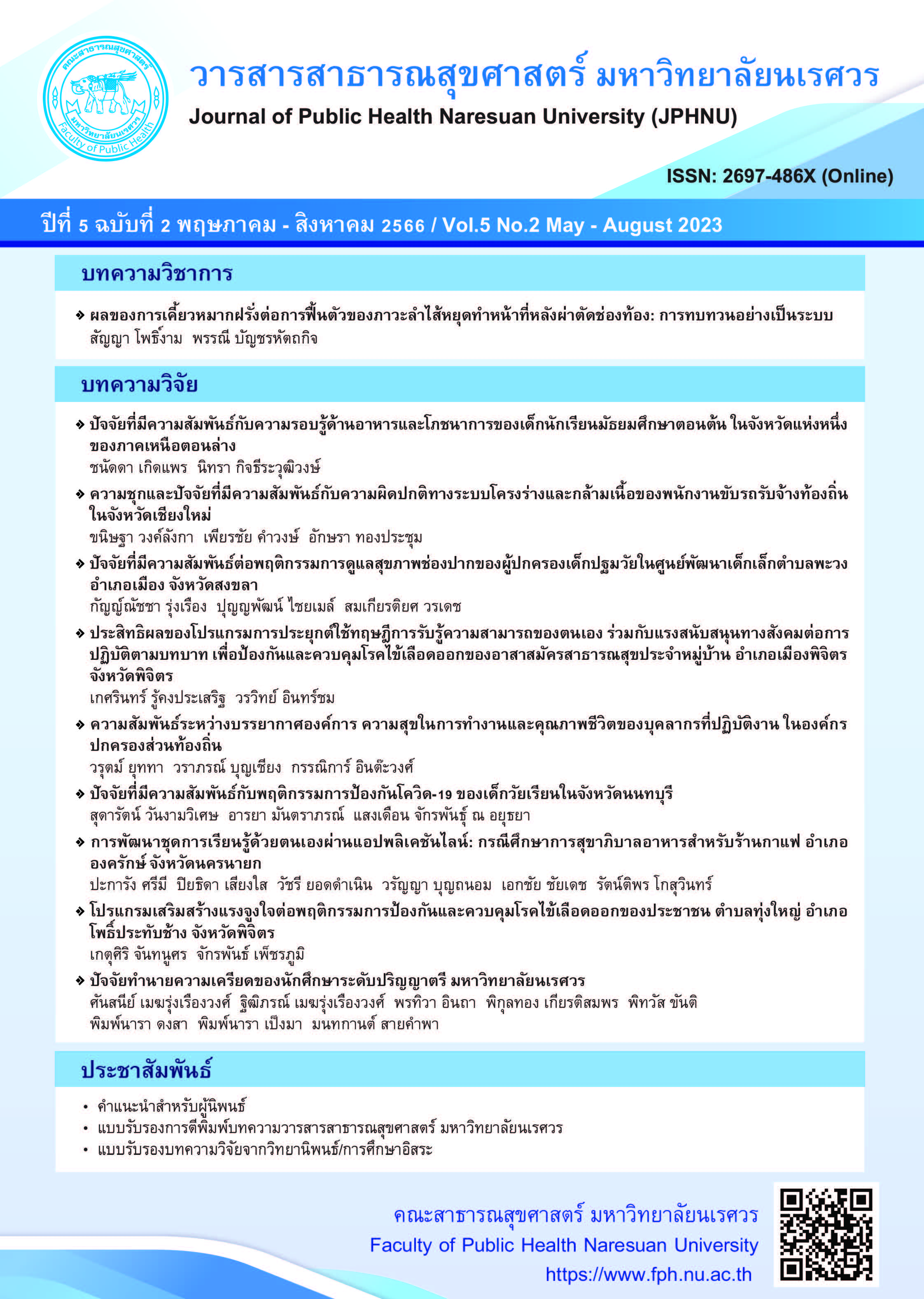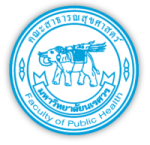Motivational enhancement program on dengue hemorrhagic fever prevention and control behaviors among residents of Thungyai Sub-District, Phoprathapchang District, Phichit Province
Keywords:
Dengue hemorrhagic fever, Motivational enhancement program, Dengue hemorrhagic fever prevention and control behaviors, MotivationAbstract
This quasi-experimental study with a two-group pretest-posttest design aimed to evaluate the effectiveness of a motivational-enhancing program on dengue hemorrhagic fever prevention and control behaviors among residents of Thungyai Sub-District, Phoprathapchang District, in Phichit Province. Ninety-eight participants were enrolled and divided into one experimental group (n = 49) and one compare group (n = 49). The experimental group attended a 3-week motivation-enhancing program consisting of 6 activities: telling stories about dengue fever, role-playing, reflection, dream imagery, skill training, and mosquito larvae monitoring. The research period was 16 weeks. Data was collected using a questionnaire, both before the program and at 4, 8, 12, and 16 weeks after the program. Data was analyzed using frequency, percentage, mean, and standard deviation. The mean differences were compared using an independent t-test, and information that was measured multiple times was analyzed using repeated-measures ANOVA.
The results showed that at 4, 8, 12, and 16 weeks after the program, experimental group participants average scores in the areas of knowledge, perceived severity, perceived risk, expectations of effectiveness in denguefever prevention and control, expectations of their ability, and dengue fever prevention and control behaviors, were significantly higher than when measured before the program. Also, the post-program scores in the experimental group were significantly higher than the final scores of the compare group (p-value < 0.05). After the program, the percentage of surveyed containers in which mosquito larvae were found in the experimental group was lower than the pre-program percentage, and the post-program experimental group percentage was also lower than the compare group's final percentage (p-value < 0.05). These results indicate that this motivation-enhancing program was an effective model that can be adopted by public health agencies.
References
Auttapoom, K., Ratanasuwan, W., & Sujirarat, D. (2017). The effectiveness of the health belief model and the participation of the community in controlling of mosquito larvae In Khummuang District, Kalasin Province. Journal of Nursing and Health Sciences, 11(2), 140-153. (in Thai)
Ban Thungyai Health Promoting Hospital. (2019). Report on the prevention and control of dengue fever. Phichit: Ban Thungyai Health Promoting Hospital. (in Thai)
Chalardlon, T., & Anansirikasem, P. (2019). Development of the community participation model of for dengue hemorhagic fever prevention and control: A case study of Thungthong village in Ladbuakhao Subdistrict, Bangpong District, Ratchaburi Province. Journal of Health Research and Innovation, 2(1), 153-162. (in Thai)
Department of Disease Control, Ministry of Public Health. (2010). Survey of mosquito larvae. Nonthaburi: Department of Disease Control, Ministry of Public Health. (in Thai)
Jakkujantr, C., Kaeodumkoeng, K., & Kengganpanich, T. (2021). Effects of the health literacy promotion program on dengue hemorrhagic fever prevention by applying IMB model for grade 5 students, Bangkok Metropolitan Administration schools. Disease control journal, 47(3), 479-489. (in Thai)
Jirawatkul, A. (2008). Biostatistics for health science research. (3rd ed). KhonKaen: Klang Nana Witthaya Publishing House. (in Thai)
Khayankannawee, W., Pattanathaburt, P., & Noosorn, N., (2021). Factors predicting preventive behaviors towards dengue fever of the people in Huai Kha Khaeng Forest line, Lansak Sub-district, Uthai Thani Province. Journal of Nursing and Health Science Research, 14(2), 1-19. (in Thai)
Laungxay, K., Loiha, K., & Srisura, D. (2020). Participation in the community in Champasak Province, Lao People’s Democratic Republic (Lao PDR). Journal of the office of DPC Khon, 29(3), 14-26.(in Thai)
Maddux, J. E., & Rogers, R. W. (1983). Protection motivation and self-efficacy: A revised theory of fear appeals and attitude change. Journal of Experimental Social Psychology, 19(5), 469-479.
Phichit Provincial Public Health Office. (2019). Dengue situation from disease surveillance reporting system. Phichit: Phichit Provincial Public Health Office. (in Thai)
Singh, A. S., & Masuku, M. B. (2014). Sampling techniques & determination of sample size in applied statistics research: An overview. International Journal of Economics, Commerce and Management, 2(11), 1-22.
Vector Borne Diseases Division, Department of Disease Control, Ministry of Public Health. (2019). Report on the situation of dengue hemorrhagic fever. Nonthaburi: Department of Disease Control, Ministry of Public Health. (in Thai)
World Health Organization. (2019, December 25). Dengue and server dengue. Retrieved December 25, 2019, from https://www.who.int/news-room/fact-sheets/detail/dengue-andsevere-dengue
Wuthidech, W., Pattanathaburt, P., & Noosorn, N., (2021). Factors affecting the role of health volunteers on prevention and control of dengue fever in the repeated outbreak areas of Muang District, Uttaradit. Disease Control Journal, 47(1), 804-814. (in Thai)
Downloads
Published
How to Cite
Issue
Section
License
Copyright (c) 2023 Journal of Public Health Naresuan University

This work is licensed under a Creative Commons Attribution-NonCommercial-NoDerivatives 4.0 International License.
The published article is copyrighted by the Journal of Public Health and Health Sciences Research.
The statements that appear in each article in this academic and research journal are the personal opinions of each author and are not related to Naresuan University and other faculty members in the university. Responsibilities regarding each article are the responsibility of each author.






